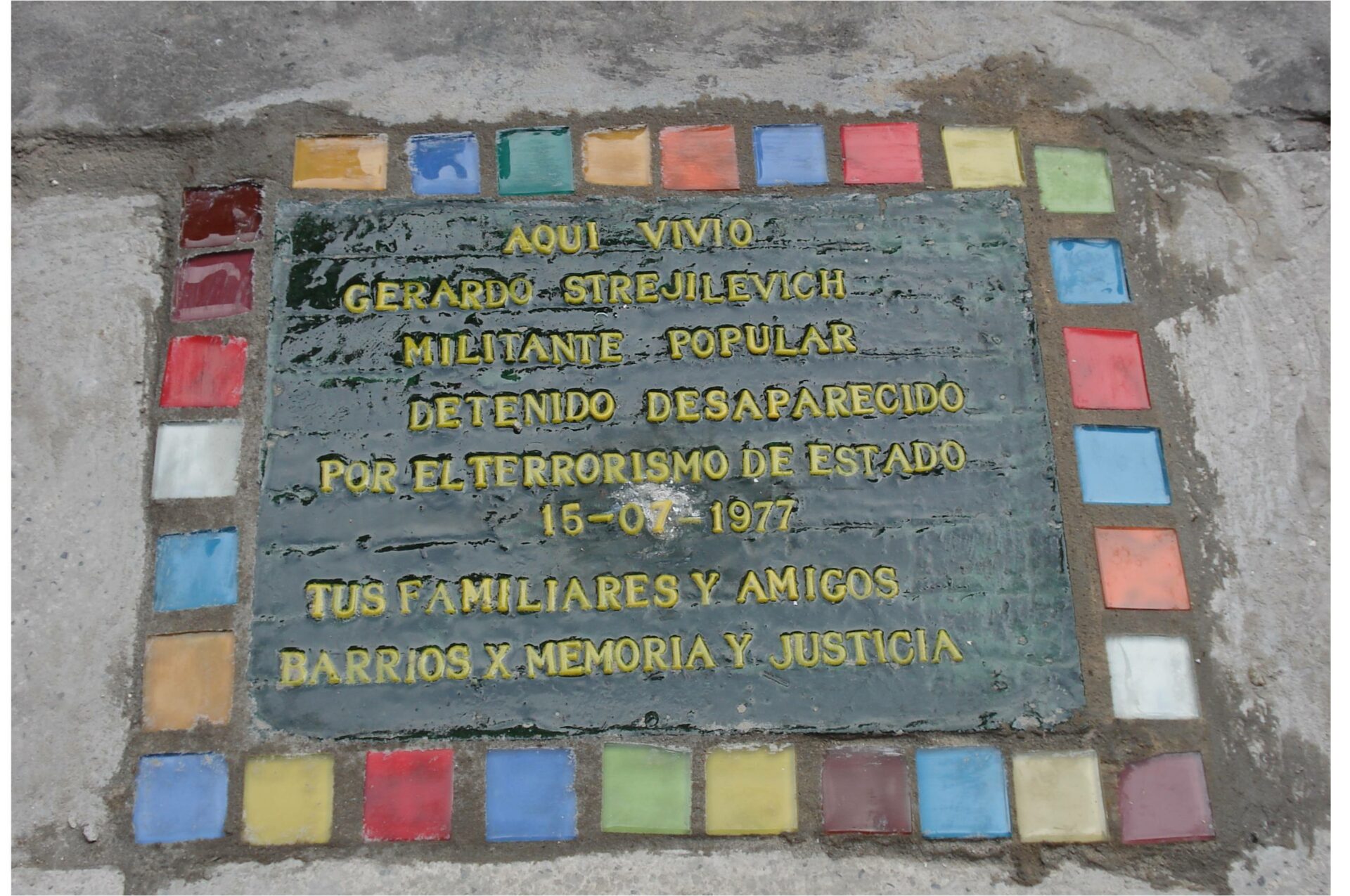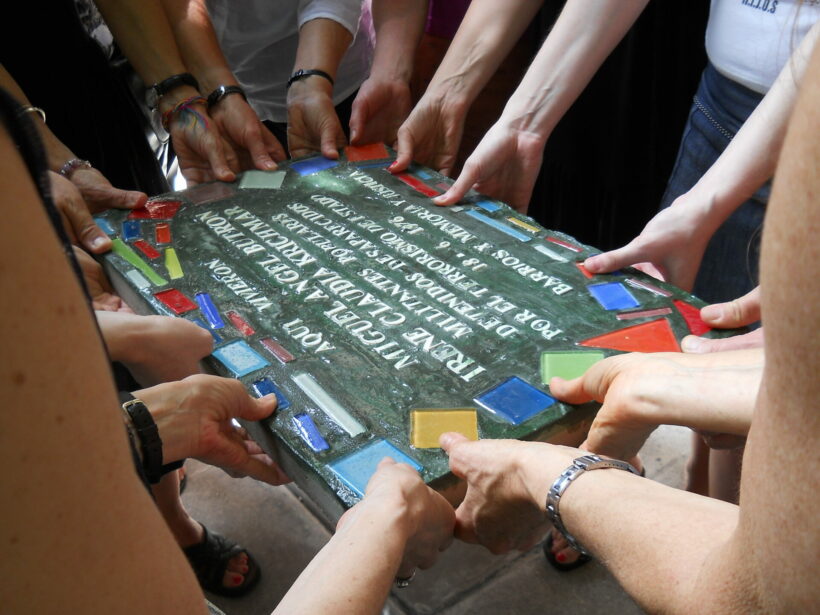By Maxine Lowy
Slowly, the crowd moves forward one step and then another and then stands still, slowly turning counterclockwise, with the Pirámide de Mayo crowned by the Statue of Liberty on the left and the Casa Rosada in front, as the Madres have done every Thursday afternoon for more than four decades. Some weeks only about twenty people accompanied them, but today, with several Mothers, assisted in wheelchairs, so many have arrived at the Plaza de Mayo that this 2380th lap is not enough to go all the way around.
Today is Thursday, 23 November, and the Mothers called for the first round following the landslide election victory, four days ago, of the self-styled ultra-liberal economist Javier Milei as president of the Argentine Republic.
Among the crowd are Mariano, 28, and Ernesto, 70. “We didn’t know each other and we all know each other,” says Mariano. “I’m between the Peronists and the left. I can’t define myself because I have criticisms for both sides. But this social cause has no political party”. Ernesto, who 49 years ago, on 1 May 1974, stood on this very spot and heard President Juan Domingo Perón disqualify the thousands of Montoneros present as “imbeciles”, causing them to leave the square and leaving a premonitory void of what was to come, agrees wholeheartedly. Ernesto’s partner ended up kidnapped by state agents and to this day is a victim of forced disappearance.
A survivor of political imprisonment, Ernesto wears on his shoulders and chest a card written in black marker: “There were 30,000 of them”. Mariano, born in a democracy, and Ernesto, deeply affected by the dictatorship, are united by the perplexity and indignation that their fellow citizens have elected a president who questions the seriousness of the human rights violations committed by the last civil-military dictatorship. They also share the
resilience characteristic of many Argentines that has allowed them to rise up, time and again, to demand justice and memory.
Time and time again to demand justice and memory. Now they both turn their attention to the words of trade union leader Daniel “Tano” Catalano.
In the middle of the crowd, they cannot see him, but they hear his voice: “It is a time of great uncertainty and it is hard for us to think how we are going to move forward. But we will pick ourselves up off the ground and see how to build. We are here to put our bodies into it and continue to support.
Carmen Arias, a member of the organisation Madres de Plaza de Mayo, quotes the historic leader Hebe de Bonafini, who died a year ago, to affirm that Javier Milei’s government “…must be resisted by fighting against it. We cannot remain silent, nor sit still, nor sit down, nor become bitter, nor cry”.
In the first debate of the then five presidential candidates on 1 October, Milei, who launched his political career in 2021 when he was elected national deputy, said that “There was a war and the forces of the State committed excesses”. During the campaign, the Secretary of Human Rights was one of the ministries that the new president Milei promised to eliminate. A couple of days before the elections, the now vice-president Victoria Villarruel said that the premises of the former Escuela de Mecánica de la Armada (ESMA), which since 2015 has been the Museum of Memory and where the offices of human rights defender organisations are located, should be converted into a school. 1 Last September, UNESCO declared the area where the Museum is located a World Heritage Site, where between 1976 and 1983 an estimated 5,000 people were tortured and killed. Only 500 survived.
The expressions of the new president and his team call into question the belief that a culture of human rights prevails in Argentina and that respect for historical memory is culturally ingrained. How to interpret the fact that it was younger voters – 16 and 17 year olds voted for the first time – who provided the decisive electoral impetus is still a matter of debate: lack of consciousness, weariness with corruption?
Felipe, an 80-year-old Argentinian living in France, writes: “In general, the old are blamed for conservative tendencies, but this time it was the young who voted for Milei. The memory of the 30,000 and human rights is no longer their problem. They are fed up with having to leave the country to look for work”. 2
 Photo by Nora Strejilevich
Photo by Nora Strejilevich
Walking the streets of many neighbourhoods in Argentina, one comes across another indicator of the force of historical memory. “Here she lived…”, “Here she worked…”, “Here she was kidnapped by state terrorism”, are colourful tiles embedded in the pavements of more than 3000 places in the Autonomous City of Buenos Aires – the capital of the country – and in the provinces.
They are daily marks of the memory that drives the artistic-political project Barrios por la Memoria y Justicia, initiated in Buenos Aires at the end of 2005.
In Chile, where gestures of memory are regularly vandalised – as in the case of the mosaics installed and repeatedly broken in front of the house where the Venda Sexy torture centre operated, with the participation of the notorious repressor Ingrid Olderock – Chilean memory activists admire the respect that Argentines show for such expressions. However, similar attacks have been occurring with increasing frequency, also in Argentina, under Mauricio Macri’s government and today.
Strolling through the quiet neighbourhood of San Cristóbal, where he works in an institute, social psychologist Enrique Ramírez Concha comes across several broken memory tiles. The son and nephew of Chilean social fighters, including his aunt Herminia Concha, an emblematic figure of the resistance, Enrique has lived for 45 years in Argentina, where his parents arrived in exile. A 2003 graduate of the Universidad Popular Madres de Plaza de Mayo, Enrique teaches children’s rights, women’s rights and human rights in general at several secondary schools. Every 24 March, the anniversary of the last military coup in 1976, schools organise events related to the coup, sometimes with the presence of a mother or grandmother who tells her story. “The commemorative tiles used to be respected, but now you see them broken with hatred. They are put back and broken again. You say to yourself: ‘What happened, why don’t people want to keep this memory? But no matter how much the new generations who voted for Milei today want to forget it, the memory lives on. 3
One of the vandalised commemorative tiles that Enrique encounters as he passes through the San Cristóbal neighbourhood commemorates Miguel Ángel Moreno Malugani, whose life was marked by persecution in three countries. Moreno was an Uruguayan who arrived in Chile in 1972 fleeing persecution in Uruguay and, after the Chilean military coup, fled to Argentina, where, in October 1976, he was disappeared by repressive agents at the age of 28.
Many of the tiles, made collectively by relatives and companions of the disappeared, guided by members of the organisation Baldosa por la Memoria, have small squares or rectangles of coloured glass on their surface. These colourful pieces have been created by visual artist Marisa Munczek, an active participant since the organisation’s beginnings. The project, explains Marisa, “challenges the population, both those who know the history and those who do not. They mark the steps among us of those who died for dreaming of a better world. They are coloured because they celebrate life, they are not tombstones”. And he clarifies: “Denialism does not arise now. It has always existed in Argentina. We saw it in the attempt to defend the military. This violence against gravestones – and in hospitals and schools where Nazi symbols appear – has been unleashed because it is authorised by the denialist discourse of the future president and above all of his vice-president”. 4 A tile that was attacked after the elections was restored this Saturday by its relatives.
In 2008, residents of the Almagro neighbourhood placed a tile in front of the building at 2583 Corrientes Street, where the scientist Gerardo Strejilevich lived until his kidnapping by state agents on 15 June 1977. His sister, Nora, also kidnapped that day, is a witness-survivor and writer known on both sides of the Andes for her reflections on inescapable memory. Together with Marisa, she attended the 2380 round at Plaza de Mayo, where she recalled what the Argentinean cultural critic Alejandro Kaufman said about the denial of a massacre or genocide: “…it is not an intervention on the past but on the future, and its aim is to break down the barriers erected against its repetition. That is why, both in Argentina and Chile, the struggle for the Nunca Más is today the struggle against this discursive erasure that brings with it the same intention to annihilate what exists, existed and will exist: resistance”. 5
 Photo by Madres de Plaza de Mayo
Photo by Madres de Plaza de Mayo
In the 21 days between the 19 November elections and his inauguration on 10 December, Milei seems to have shed some of his more extreme proposals. He is no longer heard talking about closing the Central Bank, dollarising the economy, or cutting relations with China and Brazil. The opposition hopes that his threats to close many ministries and privatise successful state enterprises such as YPF and Aerolíneas Argentinas are mere campaign bluster. If Milei tries to implement some of his more controversial measures, he is likely to face a counterweight from the majority opposition in Congress and the anger of Argentines, who are prone to express themselves in street mobilisations in answer to injustices.
Argentine lawyer Pablo Llonto, who represents Chileans in the Operation Colombo case, points the way forward. “We have to multiply the work of disseminating information about the horror of the dictatorship and those responsible for it. We have to talk about how they destroyed industry, jobs and left the country in ruins. That is why the work of memory is important, and in this we have to be very pedagogical: give examples, show the facts, show the crimes.
The trials will continue, and we will continue to demand justice even with all the existing difficulties and the obstacles they will put in our way. 6
This spirit of resilience is reflected in Marisa’s words: Every time a tile is vandalised, we will restore it. Memory is not erased and will not be destroyed.
1 This is not the first time that there have been proposals to modify or destroy ESMA. In 1998, President Carlos Menem wanted to demolish ESMA, but the survivors filed a writ of amparo that was accepted by the courts, which preserved the evidence of the crimes committed at ESMA.
This preserved the evidence of the crimes committed there, which is contained in 300 court cases.
2 Conversation 22-11-2023.
3 Conversation 22-11-2023.
4 Conversation 5-12-2023.
5 Email correspondence, 8-12-2023. Nora Strejilevich’s published books include A Single Numerous Death (1997), The Place of the Numerous (1997), The Place of the
Numerous (1997), The Place of the Witness (2019) and One Day, There by the End of the World (2019).
6 Email correspondence, 30-11-2023.






